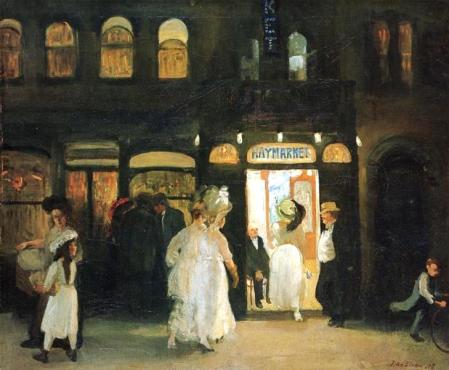Mention the original Penn Station, and most New Yorkers simply sigh—resigned to the cold reality that in 1963 the city allowed a demolition crew to tear down the 1910 “Roman temple to transportation,” with its doric columns and two-block waiting room at West 33rd Street and Seventh Avenue.
Everyone mourns that Penn Station. But what about the neighborhood that was leveled by 1904 so Penn Station could be built and completed six years later?
 Four entire blocks were demolished to make way for the station, blocks bounded by West 31st and 33rd Streets and Seventh and Ninth Avenues. (At right, West 30th and Seventh Avenue, 1903—not in the demo zone but still a good idea of the surrounding neighborhood.)
Four entire blocks were demolished to make way for the station, blocks bounded by West 31st and 33rd Streets and Seventh and Ninth Avenues. (At right, West 30th and Seventh Avenue, 1903—not in the demo zone but still a good idea of the surrounding neighborhood.)
These blocks were on the western edge of the Tenderloin: by day a functional to rundown walkups and tenements, and by night Gilded Age New York’s rollicking sin district roughly between 23rd and 42nd Streets and Sixth to Ninth Avenues.
[Above, John Sloan’s Haymarket, the name of a popular club in the Tenderloin circa 1908]
 Formerly known as “Satan’s Circus,” the area got its new colorful name after a crooked cop named Alexander “Clubber” Williams transferred to a police precinct in the Tenderloin.
Formerly known as “Satan’s Circus,” the area got its new colorful name after a crooked cop named Alexander “Clubber” Williams transferred to a police precinct in the Tenderloin.
“I have had chuck for a long time, and now I’m going to eat tenderloin,” Williams supposedly told an associate—a reference to the riches in protection money he planned to seek from local madams and gambling den owners.
But one person’s vice district is another’s home sweet home. While the Tenderloin met wealthy New Yorkers’ needs for gambling, dancing, and sex, thousands of working class and poor residents went about day-to-day life there.
 “Many respectable and hard-working folks lived and toiled here, as the recent census recorded, and by day it appeared to be just another shabby city enclave,” wrote Jill Jonnes in Conquering Gotham: a Gilded Age Epic.
“Many respectable and hard-working folks lived and toiled here, as the recent census recorded, and by day it appeared to be just another shabby city enclave,” wrote Jill Jonnes in Conquering Gotham: a Gilded Age Epic.
“When night enveloped Gotham, and Manhattan’s skyscrapers and grand hotels glowed with the wondrous electric light, the streets here became a hotbed of vice.”
Immigrant Jews, Irish, and Italians lived in crowded, sketchy apartments, working as tailors and waiters.
African Americans also resided here in relatively large numbers. (As seen in the three images on West 30th Street in 1903.) “They toiled as railroad porters, hotel porters, waiters, launderers, stable hands, and cooks,” wrote Jonnes.
Few of the people who were involved with acquiring and then demolishing these blocks saw the humanity of the residents.
The rundown area was “given up to the French and Negro colonies, to much manufacturing and to buildings that grow more and more shabby as they approach the river, finally degenerating into a slum…this section today is one of the most troublesome in New York,” Jonnes quotes one source.
 In 1901, after the site for Penn Station was selected, Pennsylvania Railroad operatives began identifying property owners and buying them out, or began getting them condemned.
In 1901, after the site for Penn Station was selected, Pennsylvania Railroad operatives began identifying property owners and buying them out, or began getting them condemned.
It probably wasn’t difficult. With a progressive city cracking down on prostitution and drinking in the early 1900s, Gotham was less likely to tolerate a vice district with, for example, an entire row of brothels like “Soubrette Row” on West 39th Street.
By 1903, many of the properties were condemned; the people who lived there dispersed to Hell’s Kitchen, Harlem, or San Juan Hill, in the West 60s.
By 1905, they were gone—replaced by an enormous pit the New York Sun called “the biggest hole ever dug in New York.”
“Where only three or four years ago something like 400 houses, shops, and other structures stood, and their 5,000 or 6,000 lived and trafficked, to-day there is nothing but earth and rock and devastation—and a small army of laborers working day and night with drills, steam shovels, and several lines of narrow gage railroad, working incessantly to make a big hole in the ground bigger and deeper,” wrote the Sun.
Five years later, Penn Station opened and dazzled New Yorkers.
[Top photo: LOC; second photo: MCNY 93.1.1.18076; third image: Haymarket, 1908 by John Sloan; fourth image: MCNY 93.1.1.15396; fifth image: MCNY 93.1.1.15398; sixth image: New York Sun, 1905; seventh image: George Bellows, 1907-1908; eighth image: NYPL; ninth image: Wikipedia]






